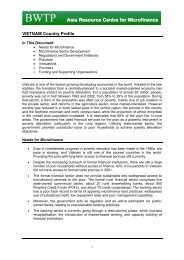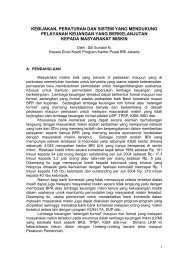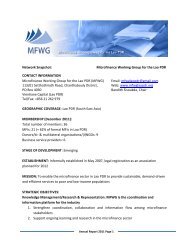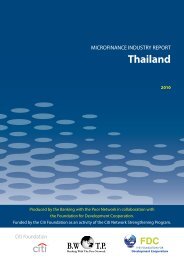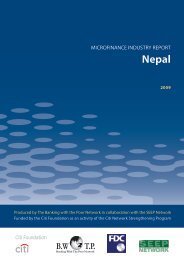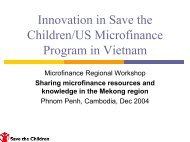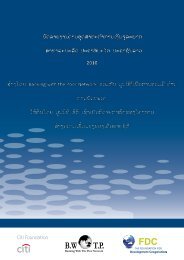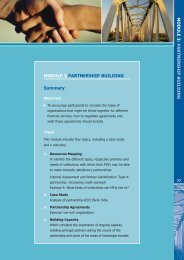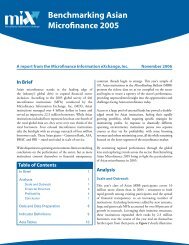Microfinance Industry Report: Indonesia - Banking with the Poor ...
Microfinance Industry Report: Indonesia - Banking with the Poor ...
Microfinance Industry Report: Indonesia - Banking with the Poor ...
You also want an ePaper? Increase the reach of your titles
YUMPU automatically turns print PDFs into web optimized ePapers that Google loves.
2. Background to <strong>Indonesia</strong>n <strong>Microfinance</strong><br />
<strong>Indonesia</strong> was one of <strong>the</strong> first countries to develop<br />
commercial microfinance in Asia, <strong>with</strong> regulated<br />
financial institutions providing <strong>the</strong> bulk of<br />
microfinance services throughout <strong>the</strong> archipelago. In<br />
addition to <strong>the</strong> success of commercial microfinance<br />
providers, <strong>Indonesia</strong> has also been a favourable<br />
ground for <strong>the</strong> development of numerous subsidised<br />
government programs, local and community-based<br />
financial institutions, cooperatives and NGOs.<br />
Despite this proliferation of microfinance service<br />
providers, several studies have demonstrated that<br />
<strong>the</strong>re is still an unmet demand for microfinance<br />
services, as a majority of rural households still do not<br />
have access to a source of funds from a semi-formal<br />
or formal institution. The regulated microfinance<br />
providers, commercial banks and BPRs (Bank<br />
Perkreditan Rakyat) follow commercial principles<br />
and tend to cover mostly <strong>the</strong> upper levels of <strong>the</strong><br />
micro-enterprise market, at <strong>the</strong> district and subdistrict<br />
levels, <strong>with</strong> loans of more than Rp. 3 million<br />
(US$300), while NGOs, cooperatives, and villagebased<br />
institutions (BKDs) reach lower towards <strong>the</strong><br />
end of <strong>the</strong> market but still have limited outreach<br />
in rural areas. Bank BRI units tend to lend primarily<br />
for investment purposes while BPRs are oriented<br />
to providing working capital. The BRI units are <strong>the</strong><br />
dominant actors; <strong>the</strong>y are estimated to receive about<br />
two-thirds of <strong>the</strong> savings mobilised in <strong>the</strong> formal<br />
and semi-formal microfinance sector and to make<br />
perhaps 40% of loans by value. BPRs have perhaps a<br />
15-20% market share of <strong>the</strong> microfinance sector.<br />
<strong>Indonesia</strong> has a long history of commercial<br />
microfinance, starting a century ago <strong>with</strong> <strong>the</strong> Badan<br />
Kredit Desa (BKD or Village Credit Organisation),<br />
which are village-owned banks offering microcredit<br />
on commercial terms. Approximately 5,000 BKDs<br />
operate in <strong>Indonesia</strong> nowadays. Sustainable<br />
microfinance in <strong>the</strong> commercial banking sector<br />
began in 1970 <strong>with</strong> <strong>the</strong> opening of Bank Dagang<br />
Bali (BDB), a private bank in Bali specialised in<br />
commercial microfinance, which built its success<br />
on <strong>the</strong> knowledge of microfinance clients and on<br />
state-of-<strong>the</strong> art savings products. Unfortunately,<br />
BDB was closed by Bank <strong>Indonesia</strong> (<strong>the</strong> central bank)<br />
in 2004 for governance reasons; <strong>the</strong> sustainability<br />
of BDB’s microbanking business model was not<br />
an issue. Ano<strong>the</strong>r significant set of institutions is<br />
operated by Bank Rakyat <strong>Indonesia</strong> (BRI), a major<br />
commercial bank. It has specialized microfinance<br />
‘units’ which have been in existence for a quarter of<br />
a century. Both large commercial banks and smaller<br />
regulated financial institutions play significant roles<br />
in <strong>Indonesia</strong>n microfinance. It is also notable that<br />
many of <strong>the</strong>se institutions are owned by one or<br />
ano<strong>the</strong>r of <strong>the</strong> various levels of government, central,<br />
provincial or local.<br />
The generic term for small regulated financial<br />
institutions in <strong>Indonesia</strong> is ‘Bank Perkreditan Rakyat’<br />
(People’s Credit Bank, or BPR). These were introduced<br />
by Bank <strong>Indonesia</strong> in 1978. After <strong>the</strong> 1988 financial<br />
reforms (known as ‘PAKTO 88’), new secondary<br />
banks were established, also called BPRs. Specific<br />
requirements for <strong>the</strong> licensing of pre-existing BPRs<br />
(capital, size of deposits) were set but never fully<br />
respected. Today, BPRs include licensed financial<br />
institutions, mostly privately-owned, that meet <strong>the</strong><br />
criteria specified in <strong>the</strong> 1992 banking law. These<br />
numbered 1,796 in August 2008 (accounting for<br />
about 15% of <strong>the</strong> microfinance market), and <strong>the</strong>re<br />
were almost 9,000 public rural financial institutions<br />
that are not licensed by Bank <strong>Indonesia</strong>. These can be<br />
categorised as generic BPRs, which include villageowned<br />
BKDs of Java and Madura, and <strong>the</strong> Lembaga<br />
Dana dan Kredit Pedesaan (LDKPs) or Rural Fund<br />
and Credit Institutions, owned mostly by provincial<br />
governments (or in some cases by villages).<br />
In <strong>the</strong> wake of new financial reforms undertaken<br />
by <strong>the</strong> government in 1984, Bank Rakyat <strong>Indonesia</strong><br />
transformed its sub-branch (‘Unit Desa’) network<br />
operating at subdistrict level. The outlets were<br />
transformed from loss-making channelling agent for<br />
<strong>the</strong> government subsidised credit program for rice<br />
cultivation (BIMAS) into commercial microfinance<br />
intermediaries. The unit network is now <strong>the</strong> largest<br />
and one of <strong>the</strong> most profitable rural microbanking<br />
networks in <strong>the</strong> developing world. During <strong>the</strong> 1997-<br />
98 financial crisis, most BRI microfinance clients kept<br />
<strong>the</strong>ir trust in <strong>the</strong> financial services offered by BRI<br />
8 microfinance industry report - INDONESIA<br />
<strong>Indonesia</strong>_<strong>Report</strong>_forprint.indd 8<br />
27/05/2009 3:14:42 PM



